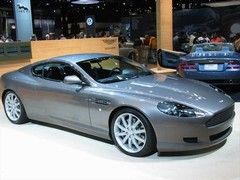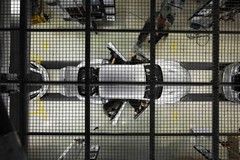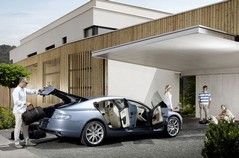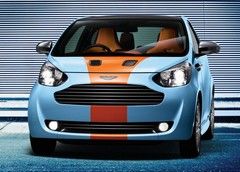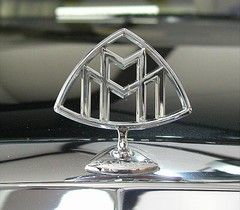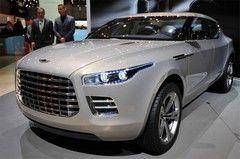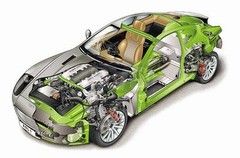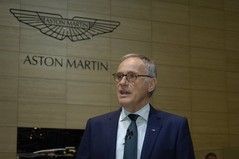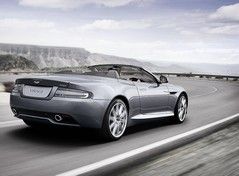Aston Martin: A Challenging Road Ahead?
PH explores the thorny issues faced by one of Britain's best loved 'superbrands'
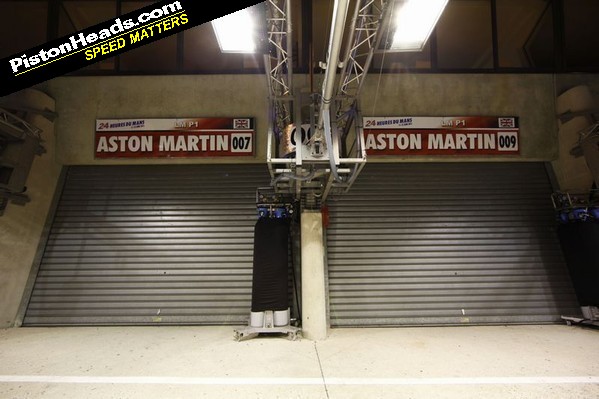
The shutters closed on Aston Martin's 2011 Le Mans fiasco - is it a sign of the times?
To be trumpeted as a new car, it will buy Aston another couple of years with its existing VH alloy platform underpinnings, refreshing technology that by 2012 will be nine years old. By the time Aston has engineered all-new models to replace the VH platform in 2015/16, the VH will be twelve-year old technology - a worrying development in the ultra competitive luxury car market.
As a sign of the times, this extension of Aston's platform technology beyond the ideal is illustrative of the tough decisions the company has had to make since the financial crisis in 2008 wrecked sales and forced a major strategic re-think.
Like most luxury sports car makers, Aston suffered a catastrophic fall in sales from a peak of 6,580 in 2007 to 3,875 in 2009, a 41 per cent drop. Aston, of course, wasn't alone. Fellow Brit luxury car maker Bentley suffered as badly, with sales down 42 per cent to 4,175 units in 2009, according to consultants IHS Global Insight.
What's the sales outlook?
Interestingly, Global Insight forecasts Aston's sales to return to their pre-crash high next year. Although much of that volume comes from the £30k Cygnet city car, the tweaked-up Toyota iQ that's just going on sale. Take out the 2,000 or so Cygnets that Global Insight is forecasting, and Aston Martin is looking at future supercar sales of around 4,500 a year, about a 1,000 fewer than originally envisaged when Ford re-launched Aston in 2003.
The revamped DB9, Vantage and Rapide are planned for replacement around 2015/16 and work on the cars is due to start in earnest in early 2012. By then, cash to design, develop and re-tool the platform and bodies for the new models should be in place.
Where's the finance coming from?
After a torrid couple of years itself in the recession, Aston's main shareholder, Investment Dar of Kuwait is now hawking a £300m bond around mid-east and Asian backers to fund the next development stages of Aston. The revamped 2012 family is funded already, sources have told PistonHeads.
Investment Dar hasn't published details of the bond - because it is not a publicly quoted company it is not obliged to. But Aston confirms that the money is for 'tidying up our finances' and will go into new models, powertrains and factory investment.
Some will be soaked up by having to buy out Magna from its assembly contract for the Rapide, which 'returns' to Gaydon in summer 2012. That leaves six years of lost revenue to compensate Magna for, and some estimates say Aston's bill with Magna could be as high as £10m.
The timing makes sense though. As the Rapide gets a revamp next year and will be partly re-tooled, it can be tied in with the upheaval of a major production-line shift.
So was the Rapide a good idea?
A long-wheelbase DB9 was originally part of Ford's long-term planning for Aston Martin. But it is hard not to conclude that Aston over-called the volume on the handsome four-door.
Despite a favourable press reaction, the Rapide hasn't caught buyers' imaginations. Aston planned the Rapide around production of 40 per week or 2000 a year and production peaked at 55 to 60 a week last year as volume was ramped up to provide dealers with demonstrators.
Aston is coy about the exact production numbers and the official build sheet says a steady running rate of 25 cars a week has been planned and continues to be planned. But the week after the Royal Wedding in May, contractors were confronted with an unplanned line stoppage for the whole month. 'Production stopped because there was a factory shutdown,' confirms Aston.
Is the Cygnet going to go the same way?
Maybe. The press reaction has been good and Aston claims 400 orders, mostly from existing multi-millionaire owners who desire a hand-trimmed and exclusive city car to replace the volume-selling small car that most count in their extensive fleets.
The fact that Aston customers asked for a car like the Cygnet suggests that demand, ironically, might hold up better than the Rapide. But the huge challenge for Aston is to keep demand up over the six-year contract at the rate of 2,000 cars a year it has told Toyota it wants. How many Cygnet owners will order another in three or four years time?
Some marketing experts reckon that the Cygnet is a 'brand extension' too far and that Aston should concentrate on 'product extensions' like the Rapide. In London, where the bulk of UK demand will be, the Cygnet also suffers a CO2 output higher than the sub-100g/km limit required to be congestion charge exempt.
Aston also plans to take the Cygnet global, including the US from late 2012 for the 2013MY, which will be a big ask outside LA, NY and the east coast. Will that also leave Aston with plenty of production capacity, but no buyers, like the Rapide?
What about a partner?
Perhaps the most exciting, but also threatening, development is a possible tie-up with Mercedes-Benz. Exciting because access to Mercedes technology will secure a solid basis for cars well into the next decades, but threatening because Mercedes will surely demand a strong say in Aston's strategy. Just ask McLaren how that works.
From the outside it looks like Aston is keener than Benz on this deal. Just before Geneva in 2009, the two agreed to co-operate to help Aston re-launch Lagonda. The project would also showcase the skills that Mercedes was looking for to make a success of the Maybach brand, which has been over-shadowed by Rolls-Royce.
It may be that Benz's interest was sparked by the expertise of Aston's design chief Marek Reichmann, who was a key player in 'Project Bank', BMW's ground-up design of the new RR Phantom. For the Lagonda re-launch, Benz supplied a GL 4x4 and Aston created the car, but the styling was not well received. Things have gone very quiet since then, although Aston maintains 'it is always talking to potential partners'.
This year it is trying to rekindle the relationship by offering to do at least one, and maybe two, concept cars for Maybach, most likely to be shown at Frankfurt in September.
Daimler boss Dieter Zetsche has also cryptically referred to Maybach's future being tied to a partner and a decision coming soon, fuelling speculation that Aston and Maybach will announce a tie-up soon. Mercedes designers, meanwhile, continue to work on the next Maybach models.
How would Aston benefit?
Two critical strategic steps have to be taken - a new chassis platform and engines - and Mercedes has both. The new SL has an alloy spaceframe shared with the SLS, and of course, almost any petrol engine configuration, including V12, V8 and straight sixes is available from Benz.
Our sources say that work on Aston's all-new replacements for the DB9 family and their platform starts in earnest early in 2012, so getting a platform base tied-down is vital.
There's also the possibility that Aston might not re-sign a technology deal with Lotus. Some years ago, the Hethel company bought-out Aston's main supplier of alloy chassis, then called Hydro, which also makes the Elise chassis.
That would free the way for Aston to adopt Mercedes chassis tech. Depending on how a partnership was constructed, it might also allow Aston to be included in the EU's calculations of average fleet carbon dioxide output. The Cygnet will help Aston balance its numbers in Europe, but at what cost to its brand image?
Is the management up to it?
When Ford sold Aston to the Kuwaitis in 2007, a financier John Sinders, was appointed to referee the two dominant personalities - CEO Uli Bez and chairman Dave Richards. Sinders left soon after and, according to insiders, Uli Bez continues to exert a strong hold over Aston.
Bez drove many of the good decisions that set Aston on its meteoric rise in the mid-2000s and the One-77 is a magnificent creation. But the track record on Rapide production isn't great and the Cygnet has yet to prove itself.
More worrying is the continuing re-branding and re-launching of versions of the DB9 and Vantage, which looks like Aston's car development programme is in a holding pattern, not forging ahead with vital new models.
Aston's motorsport involvement has been mixed, too. Class wins in GT racing were a great starting point. But exposing a new six-cylinder engine at Le Mans this year, only for both cars to retire on the first lap, doesn't look clever. Shouldn't a global brand like Aston be chasing overall honours?
Bez has also talked about developing Aston's own road car six, possibly related to the race engine. But should this be a priority? On the positive side, if Bez can pull-off the right strategic partnership to secure Aston's future, he'll have more than compensated.
So what's the outlook?
Aston has so far weathered the worst recession since the 1930s, something it wouldn't have managed at almost any other time in its history. And a new range of refreshed models are on sale late next year, although how much appetite there will be for yet more variants of today's DB9 and Vantage has yet to be seen. More significantly, the $300m bond placing has to be a success, as has the search for a strategic partner.
These are significant questions about Aston's future that time, hopefully, will answer in the affirmative.
(Article researched and written for PistonHeads by Julian Rendell)
However the new Virage or whatever its called is just a complete cop out, a mildly rehashed DB9 with a slight performance increase, they were trying to say that it was a new car, pull the other one
Also the One-77 is ugly as sin, but i understand they all sold out so someone must like them
Aston hitched their wagon to a very unusual set of market conditions and adapting to their absence is going to be very difficult indeed. There are a lot of first-time Aston buyers (with less cash than they used to have) worriedly contemplating realising big losses on their current cars if they buy another, and there hasn't been much development in the range to make buying a new one a compelling decision.
Is a £120k 2011 Aston really much (any?) better than the £40k 2004 car you've already got?
I'd like to see some of the one-77 DNA in the new models. Hopefully management can get the right partnerships in place and get rid of the dead wood in the range (and boardroom) and step it up.
COME ON ASTON !!!
We dont see porsche or any other profitable (there are not so many) carmakers totally reinventing their chassis building technique. Why would they? I dont understand that a reskin is a step sidewards. Most new production models have enormous carryover from the last one, despite the bulls
 tting by marketing depts.
tting by marketing depts.Astons future is clearly as a "super luxury" brand so descending the value chain cannot be the answer. I would have thought a sensible technology partnership to remove some of the core powertrain, safety and technology/software costs together with a rigorous approach to increasing the per-product profit (as they have been doing) is potentially sustainable assuming the core growth in volume comes from the developing markets. Aston is a global brand that, I think, derives the majority of its volume from it's traditional markets (US and Europe). This may mean some products that are not designed for typical PH taste but if they're beautiful and suitably high-end then the brand will survive them quite merrily I would have thought.
Cygnet is surely a side show to all of this - it will neither make nor break the company?
I really cannot see why people complain about the cars looking similar, look at the 911 for a prime example, you don't change something unless it isn't working. Plus the fact that the cars are quite different to drive. Personally, I believe the Rapide will be the model that saves Aston, when sales start coming in from the Chinese market.
We dont see porsche or any other profitable (there are not so many) carmakers totally reinventing their chassis building technique. Why would they? I dont understand that a reskin is a step sidewards. Most new production models have enormous carryover from the last one, despite the bulls
 tting by marketing depts.
tting by marketing depts.The DB7 was based on a 20 year old design (XJ-S) when it was launched - if it works what's the problem? As long as the technology is there and the styling is enough of a move forward that's the main thing.
Aston Martin had "LIABILITY" written all over it when it came up for sale by Ford. Aston had, by 2007, performed a couple of one-hit wonders: the VH chassis and the "baby Aston". The cost to replace the VH chassis will be beyond the firepower of a private company; the "baby Aston" has soaked the market with Aston Martins and created a huge mouth to feed at Gaydon. Of course, the VH chassis can be re-skinned and cut'n'shut to chase niches with variants of variants of variants, none of which will generate the surpluses required for a return on investment let alone invest in VH's successor. Emissions legislation is going to hammer Aston Martin because it doesn't belong to a group against which its products' gas guzzling emissions can be offset.
Aston Martin was never going to weather an economic decline very well which, given that people were widely aware of the economy peaking in 2007, makes it all the more surprising that somebody was willing to pay Ford a billion dollars at the market peak. Peak also equals start point of decline.
The novel VH platform hasn't made enough money for A-M to develop a successor ...so there's a $300M call for capital.
"A challenging road ahead" indeed. Aston Martin will survive for as long as there are people prepared to pay [$300M] for it to. Plus ca change....
AML need to concentrate on there core customers, making expensive unique and low volume models, but that never looks a "good" business plan, as people always ask "when are we going to grow" etc!
The 7k plus sales peak of the mid 2000's was due to a decent financial market and a briefly nearly class leading (and desirable) car. It sounds simple, just make cars people want (although it seemed to take JLR about 12 years to get that bit right......), and then they will buy them.
Building a stable and sustanable company is about having a decent basic model line up, and making circa 3-4k of them a year from Gaydon. And i suspect, with the pressures on CO2 etc, even that will be pretty tough. Considering the customer base however, i think more rests on a new "styling direction" than actually having cutting edge powertrains in the cars (although a 400bhp / sub 200g/km I6 DISI turbo can't come soon enough from a legislative perspective)
The other trick that can be difficult to pull off, is to ensure you have a model range than doesn't steal sales off itself. With the release of the V8V, AML had a car that cost almost the same to make (as the DB9) but was being sold for over £30k less, and being bought buy people who otherwise might have bought a DB9. Platform sharing simply is the wrong idea if it means you sell more of the less profitable cars and less of the more profitable ones.......... (hence there subsequent push to develop a range of more expensive DB9 based cars (DBS etc) with which to readdress the balance).
I really cannot see why people complain about the cars looking similar, look at the 911 for a prime example, you don't change something unless it isn't working. Plus the fact that the cars are quite different to drive. Personally, I believe the Rapide will be the model that saves Aston, when sales start coming in from the Chinese market.
Rapide wont get the numbers Aston want and they would do well not wasting their time on the executive car market that is saturated with BMW's and Mercedes and get back to basics and churn out iconic sports cars and stick to what they know
Also the 911 is an exception. always has been always will be.
Wouldn't there be a better tie-up with Lotus? Assuming Behar can deliver the platforms they need, the project trajectories of the two brands would seem to coincide somewhat, and it would help maintain the 'britishness' of the two brands.
If not, then how about JLR? They're developing some new platforms at the moment aren't they? Again, the brand would be left intact and it would retain the low-volume nimbleness it has now.
There has to be a better partner than MB, which just parks its big, fat corporate backside on everything it touches and crushes its spirit.
Gassing Station | General Gassing | Top of Page | What's New | My Stuff

